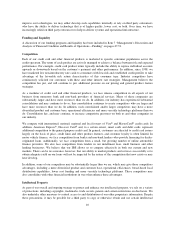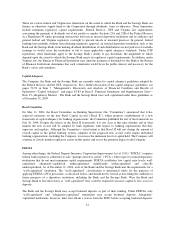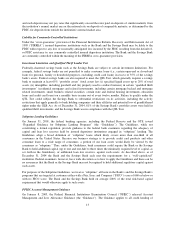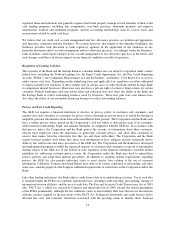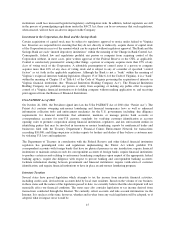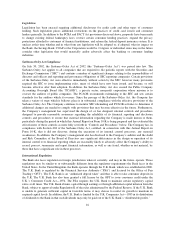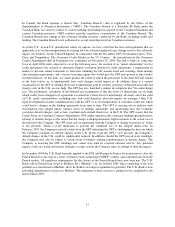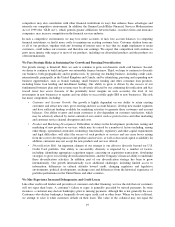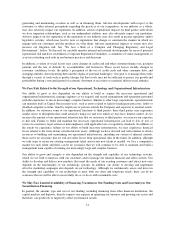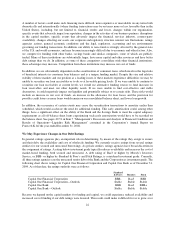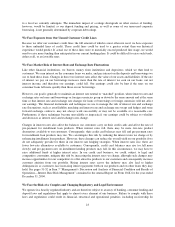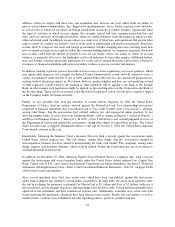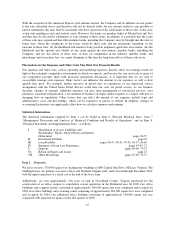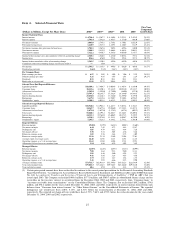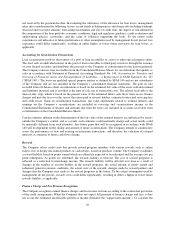Capital One 2004 Annual Report Download - page 42
Download and view the complete annual report
Please find page 42 of the 2004 Capital One annual report below. You can navigate through the pages in the report by either clicking on the pages listed below, or by using the keyword search tool below to find specific information within the annual report.competitors may also consolidate with other financial institutions in ways that enhance these advantages and
intensify our competitive environment. In addition, the Gramm-Leach-Bliley Financial Services Modernization
Act of 1999 (the “GLB Act”), which permits greater affiliations between banks, securities firms and insurance
companies, may increase competition in the financial services industry.
In such a competitive environment, we may lose entire accounts, or may lose account balances, to competing
financial institutions, or find it more costly to maintain our existing customer base. Customer attrition from any
or all of our products, together with any lowering of interest rates or fees that we might implement to retain
customers, could reduce our revenues and therefore our earnings. We expect that competition will continue to
grow more intense with respect to most of our products, including our diversified products and the products we
offer internationally.
We Face Strategic Risks in Sustaining Our Growth and Pursuing Diversification
Our growth strategy is threefold. First, we seek to continue to grow our domestic credit card business. Second,
we desire to continue to build and grow our automobile finance business. Third, we hope to continue to diversify
our business, both geographically and in product mix, by growing our lending business, including credit cards,
internationally, principally in the United Kingdom and Canada, and by identifying, pursuing and expanding new
business opportunities, such as branch banking, small business lending and other consumer loan products,
including home loan lending and installment lending. Our ability to grow is driven by the success of our
fundamental business plan and our revenue may be adversely affected by our continuing diversification and bias
toward lower loss assets (because of the potentially lower margins on such accounts), the level of our
investments in new businesses or regions and our ability to successfully apply IBS to new businesses. This risk
has many components, including:
•Customer and Account Growth. Our growth is highly dependent on our ability to retain existing
customers and attract new ones, grow existing and new account balances, develop new market segments
and have sufficient funding available for marketing activities to generate these customers and account
balances. Our ability to grow and retain customers is also dependent on customer satisfaction, which
may be adversely affected by factors outside of our control, such as postal service and other marketing
and customer service channel disruptions and costs.
•Product and Marketing Development. Difficulties or delays in the development, production, testing and
marketing of new products or services, which may be caused by a number of factors including, among
other things, operational constraints, technology functionality, regulatory and other capital requirements
and legal difficulties, will affect the success of such products or services and can cause losses arising
from the costs to develop unsuccessful products and services, as well as decreased capital availability. In
addition, customers may not accept the new products and services offered.
•Diversification Risk. An important element of our strategy is our effort to diversify beyond our U.S.
Credit Card portfolio. Our ability to successfully diversify is impacted by a number of factors,
including: identifying appropriate acquisition targets, executing on acquisition transactions, developing
strategies to grow our existing diversification business, and the Company’s financial ability to undertake
these diversification activities. In addition, part of our diversification strategy has been to grow
internationally. Our growth internationally faces additional challenges, including limited access to
information, differences in cultural attitudes toward credit, changing regulatory and legislative
environments, political developments, exchange rates and differences from the historical experience of
portfolio performance in the United States and other countries.
We May Experience Increased Delinquencies and Credit Losses
Like other credit card lenders and providers of consumer and other financing, we face the risk that our customers
will not repay their loans. A customer’s failure to repay is generally preceded by missed payments. In some
instances, a customer may declare bankruptcy prior to missing payments, although this is not generally the case.
Customers who declare bankruptcy frequently do not repay credit card or other loans. Where we have collateral,
we attempt to seize it when customers default on their loans. The value of the collateral may not equal the
19



